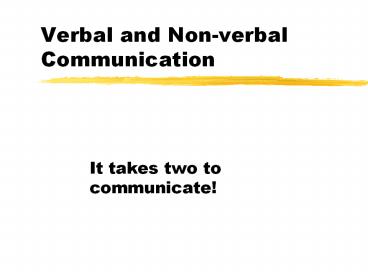Verbal and Non-verbal Communication It takes two t - PowerPoint PPT Presentation
1 / 22
Title:
Verbal and Non-verbal Communication It takes two t
Description:
Verbal and Non-verbal Communication It takes two to communicate! Four Elements of Communication Sender-generates information, thoughts, ideas or feelings Message ... – PowerPoint PPT presentation
Number of Views:148
Avg rating:3.0/5.0
Title: Verbal and Non-verbal Communication It takes two t
1
Verbal and Non-verbal Communication
- It takes two to communicate!
2
Four Elements of Communication
- Sender-generates information, thoughts, ideas or
feelings - Message- generated by sender and responded to by
receiver.
3
Four Elements of Communication
- Channel-medium in which message in transmitted
- Visual-seeing
- Auditory-hearing
- Kinesthetics-feeling, touch
- Receiver
4
Verbal Communication
- Loudness
- Fluency
- Rate of Speech
- Affect
- Language used
5
Nonverbal Communication
- Reinforces, supports and enhances verbal messages
- 55-of messages are non-verbal
- 38 are volume and tone
- Leaving only 7 as verbal words
6
Examples of Non-Verbal
- Eye Contact
- Facial Expression
- Gesture Posture
- Body Orientation
- Distance
- Appearance
7
Listening
- Components
- Hearing-process of perceiving sounds
- Attending- decision of listener based on
wants/needs - Understanding-interpreting
- Remembering
8
Barriers to Listening
- Physical and mental characteristics-ability to
hear, mental ability - Preconceptions
- Self Absorption-preoccupied
9
Health Literacy
- What is Health Literacy?
- Ability to read, understand and act on medical
information - Examples services, appointments, directions
which all affect the patients health decisions - Estimated half of all American adults lack that
skill
10
Health Literacy
- Clinicians need to address this issue
- 73 billion dollar expenditures due to low health
literacy - This increases costs due to longer hospital
stays, unnecessary doctor visits, neglect to fill
prescriptions or follow them
11
Health Literacy
- Most people read at an 8th grade level and
sometimes lower - People do not want anyone to know they can not
read or do not understand
12
Health Literacy
- American Medical Association has established a
protocol to by used by all clinicians to make
sure patients understand - Watch the Health Literacy video
13
Four Behavior Styles That Affect Communication
- Non-Assertive
- Aggressive
- Passive Aggressive
- Assertive
14
Space and Territoriality
- Social Space-4-12 ft appropriate for
introduction - Personal Space-18-4ft close enough for personal
conversation - Intimate Space- 0-18 appropriate for exams,
assessments
15
Written Communication
- Examples of Written Communications in Health Care
- Prescriptions
- Patient Instructions
- Case Reports
- Patient Progress Notes
- Lab Reports
- Memos
16
Rules for Written Communication
- Write legibly
- Spell Correctly
- Include pertinent information
- Time
- Date
- Patient name
17
Pertinent Information Continued
- Accurate information
- Be as neat as possible
- Orderly and understandable
- Concise and complete
- Keep the patient record current
- Sign or initial all information added
18
The Record...
- Is any form of documented information
- Includes the known facts of event
- Is a permanent long lasting account
- May be kept on
- Paper
- Computer
- Film
19
Documenting Data
- Objective What can be observed using any of the
senses (see, hear, touch, smell) - skin rash
- pulse rate
- dampness of skin
- vomited 300 cc
- client refuses to eat
- Subjective Described data (feeling, opinion)
- That which the client describes to you
- Can be felt or described only by the client
- Reported by quoting the client exactly
20
Correcting the Record
- DO NOT ERASE OR OBLITERATE ANY INFORMATION
- How to correct a handwritten entry
- Draw one line through the error
- Insert the correction above or immediately
following the error - Put your initials and date next to the correction
21
Key Points to Remember About Health Records
- Accuracy is essential
- Records are legal and can be used in court
- Can refresh memory when needed
- Failure to keep records can result in negligence
- Can be viewed by many people
22
Key Points to Remember About Health Records
- Be very careful about using abbreviations
- JCAHO has made a list of error-prone
abbreviations, symbols and dose designations - If in doubt, write it out































